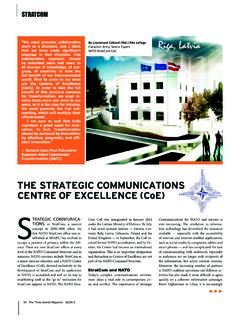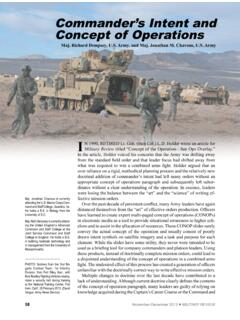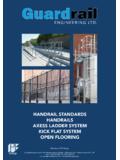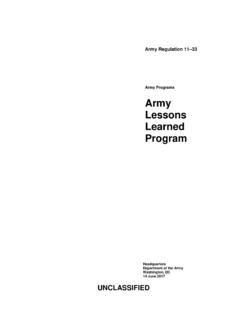Transcription of SPOTLIGHT COMMANDER'S CRITICAL INFORMATION …
1 The Three Swords Magazine 34/2019 15 SPOTLIGHTCOMMANDER'S CRITICAL INFORMATION REQUIREMENTIMAGINE IF YOU WILL THE FOLLOWING TRAINING SCENARIO. Adversary units were reported crossing the border into Allied territory signaling an imminent major ground incursion. A commander s CRITICAL INFORMATION Requirement had been triggered, which referred to airspace, territorial waters, or border violations. The staff informed the commander and assessed that it would take three hours for the adversary vanguard to reach Target Area of Interest. Adversary forces were no longer contained, but the commander had suf cient time to direct his component commanders to initiate the Contingency Plans (CONPLANs).
2 He had been given relevant INFORMATION necessary to make a timely decision, and he was pleased with his JAGUAR 2018 Photo by JWC PAOby Lieutenant Colonel Gary Giles Royal MarinesObserver/Trainer Transformation Delivery DivisionNATO Joint Warfare CentreRequirement, or CCIR, ensured that the com-mander was able to be proactive, adjust the op-erational design, initiate the necessary action and maintain the Joint Task Force (JTF) e orts in prosecuting this campaign. CCIRs comprise INFORMATION required for the commander to make timely decisions for mission accomplishment and are either CRITICAL for the success of the mission or repre-sent a CRITICAL threat to the mission.
3 Erefore, Friendly Force INFORMATION Requirements (FFIRs) and Priority INFORMATION Require-ments (PIRs) are essential elements in the management of the CCIR. e Joint Warfare Centre (JWC) sta is uniquely privileged in being able to observe NATO exercises and the varied approaches WHILST what was just described seems a simple process, making timely and appropri-ate decisions is a fundamental component of a Joint Headquarters' success on o perations. Yet, it o en becomes unne cessarily complex due to the vast amount of INFORMATION received by the headquarters.
4 In the example above, the com-mander was being guided toward future stra-tegic decisions that required his close attention rather than reacting to the threat, leaving the components under his command to deal with the close battle. e blizzard of data that was out there had been re ned into a relevant, co-hesive and usable set, which could directly aid his decision-making. Correct use of what we call the COMMANDER'S CRITICAL INFORMATION 16 The Three Swords Magazine 34/2019 Members of the JWC Training Team at JFC Naples during TRIDENT JUNCTURE 2018 CPX.
5 Photo by JWC PAOfrom di erent JTF headquarters, whether from the NATO Command Structure or the NATO Force Structure. e JWC Training Teams, in particular, observe and provide mentoring at all stages of the Exercise Planning Process, and get an eagle's eye overview of the end-to-end process. One area which has presented chal-lenges for JTF headquarters' sta s in recent exercises is that of the creation and manage-ment of the CCIR. Although a common trend, the reasons for this apparent "blind spot" are unclear.
6 CCIRs should meet the following to achieve the best e ect: CCIRs need to be managed and assigned to a custodian probably in J-3/5 Division and there should be consistency in their management; e CCIR noti cation matrix should not be a "commanders' noti cation requirement" (CNR), which resembles a COMMANDER'S "wake-up call" list; CCIRs should relate specifically to the Decision Points (DPs) on the operational framework or vice versa; COMMANDER'S approval of CCIRs must come early in the process; The Combined Joint Operations Centre (CJOC) must be fully conversant with the CCIR and the procedure for "triggering" action rehearsed and understood.
7 But then again what exactly are CCIRs? In STANAG 2248, the CCIR is de ned as an " INFORMATION requirement identi ed by the commander as being CRITICAL in facilitating timely INFORMATION management and the deci-sion-making process that a ect successful mis-sion accomplishment."1 Simply put, the e ectiveness of the commander is proportional to his decision-making e ectiveness, and how that translates into action. e volume of INFORMATION avail-able to the 21st century commander is greater than at any time in history, but in order for that INFORMATION to be useful in assisting the COMMANDER'S decision-making, it needs to be ordered and analyzed.
8 Additionally, as their time is precious, INFORMATION presented needs to be digestible and relevant. e CCIR o ers a means of distilling the INFORMATION to that which is most relevant to the mission. Current doctrine is good at pointing out the place of decision-making in the process, but arguably not so good at the "how". e explanation of the CCIR in the process could also be , the term CCIR is also fre-quently used in the non-operational sphere to describe administrative priorities for com-manders, which adds further confusion for sta not familiar with using CCIRs.
9 E CCIR is not a noti cation matrix nor a list of the comman der's administrative priorities in bar-racks, and yet the term is o en used in this way. Where this occurs, it confuses the pur-pose of the CCIR in the Operational Planning Process environment. CCIRs are not simply a list of things a commander may wish to know; for example, casualties and equipment losses. Clearly, commanders would wish to be aware of these too, but they do not constitute a CCIR, unless they are directly rela ted to DPs and re-quire a time- CRITICAL decision.
10 CCIRs should2: focus the staff on supporting COMMANDER'S CRITICAL decisions be linked to important DPs be both decision- and time- CRITICAL be driven by the commander be continually be revised and updatedAdditionally, FFIRs and PIRs are derived from the CCIRs, not vice versa; and the sta must be trained and exercised in the use and triggering of CCIRs prior to any ' management So, how should the CCIR be created and ma naged to best e ect? In short, the three main stages are as follows (see Figure 1): The Joint Operations Planning Group (JOPG) identi es DPs and develops the The Three Swords Magazine 34/2019 17 The volume of INFORMATION available to the 21st century commander is greater than at any time in history.




